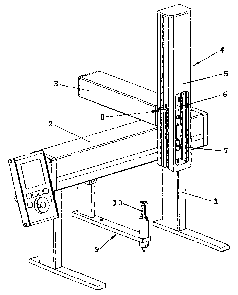Some of the information on this Web page has been provided by external sources. The Government of Canada is not responsible for the accuracy, reliability or currency of the information supplied by external sources. Users wishing to rely upon this information should consult directly with the source of the information. Content provided by external sources is not subject to official languages, privacy and accessibility requirements.
Any discrepancies in the text and image of the Claims and Abstract are due to differing posting times. Text of the Claims and Abstract are posted:
| (12) Patent Application: | (11) CA 2597721 |
|---|---|
| (54) English Title: | APPARATUS FOR COUPLING-ON AN ADDITIONAL DEVICE |
| (54) French Title: | DISPOSITIF POUR ACCOUPLER UN DISPOSITIF COMPLEMENTAIRE |
| Status: | Deemed Abandoned and Beyond the Period of Reinstatement - Pending Response to Notice of Disregarded Communication |
| (51) International Patent Classification (IPC): |
|
|---|---|
| (72) Inventors : |
|
| (73) Owners : |
|
| (71) Applicants : |
|
| (74) Agent: | BLAKE, CASSELS & GRAYDON LLP |
| (74) Associate agent: | |
| (45) Issued: | |
| (86) PCT Filing Date: | 2005-11-07 |
| (87) Open to Public Inspection: | 2006-05-11 |
| Availability of licence: | N/A |
| Dedicated to the Public: | N/A |
| (25) Language of filing: | English |
| Patent Cooperation Treaty (PCT): | Yes |
|---|---|
| (86) PCT Filing Number: | PCT/CH2005/000653 |
| (87) International Publication Number: | CH2005000653 |
| (85) National Entry: | 2007-05-07 |
| (30) Application Priority Data: | ||||||
|---|---|---|---|---|---|---|
|
The invention relates to the temporary coupling of an instrument (10) or tool
to a transport mechanism by means of a coupling ring (13) that is located
laterally on the side of a part that can be displaced in a Z-direction, said
ring comprising several preferably concentric permanent magnets (16) that are
located on its underside and offset at an angle in relation to one another.
The coupling ring co-operates with a coupling plate (17) that is located on
the upper face of the respective instrument that is to be coupled, said
coupling plate comprising permanent magnets with opposing poles (19) that are
distributed to correspond with the concentric magnets.
L'invention concerne l'accouplement temporaire d'un instrument (10) ou d'un outil à un mécanisme de transport au moyen d'un anneau d'accouplement (13) disposé latéralement sur une pièce mobile se déplaçant en Z du dispositif de transport, cet anneau comportant plusieurs aimants permanents (16) disposés sur sa face inférieure de préférence de manière concentrique avec décalage angulaire. L'anneau d'accouplement coopère avec une plaque d'accouplement (17) montée sur la face supérieure de l'instrument à accoupler, cette plaque d'accouplement étant pourvue d'aimants permanents (19) de pôle opposé répartis de façon correspondante.
Note: Claims are shown in the official language in which they were submitted.
Note: Descriptions are shown in the official language in which they were submitted.

2024-08-01:As part of the Next Generation Patents (NGP) transition, the Canadian Patents Database (CPD) now contains a more detailed Event History, which replicates the Event Log of our new back-office solution.
Please note that "Inactive:" events refers to events no longer in use in our new back-office solution.
For a clearer understanding of the status of the application/patent presented on this page, the site Disclaimer , as well as the definitions for Patent , Event History , Maintenance Fee and Payment History should be consulted.
| Description | Date |
|---|---|
| Application Not Reinstated by Deadline | 2011-11-07 |
| Time Limit for Reversal Expired | 2011-11-07 |
| Inactive: Abandon-RFE+Late fee unpaid-Correspondence sent | 2010-11-08 |
| Deemed Abandoned - Failure to Respond to Maintenance Fee Notice | 2010-11-08 |
| Inactive: Declaration of entitlement - Formalities | 2007-12-13 |
| Inactive: Cover page published | 2007-09-27 |
| Inactive: Notice - National entry - No RFE | 2007-09-25 |
| Inactive: First IPC assigned | 2007-09-18 |
| Application Received - PCT | 2007-09-17 |
| National Entry Requirements Determined Compliant | 2007-05-07 |
| Application Published (Open to Public Inspection) | 2006-05-11 |
| Abandonment Date | Reason | Reinstatement Date |
|---|---|---|
| 2010-11-08 |
The last payment was received on 2009-11-03
Note : If the full payment has not been received on or before the date indicated, a further fee may be required which may be one of the following
Patent fees are adjusted on the 1st of January every year. The amounts above are the current amounts if received by December 31 of the current year.
Please refer to the CIPO
Patent Fees
web page to see all current fee amounts.
| Fee Type | Anniversary Year | Due Date | Paid Date |
|---|---|---|---|
| Basic national fee - standard | 2007-05-07 | ||
| MF (application, 2nd anniv.) - standard | 02 | 2007-11-07 | 2007-05-07 |
| MF (application, 3rd anniv.) - standard | 03 | 2008-11-07 | 2008-10-30 |
| MF (application, 4th anniv.) - standard | 04 | 2009-11-09 | 2009-11-03 |
Note: Records showing the ownership history in alphabetical order.
| Current Owners on Record |
|---|
| CTC ANALYTICS AG |
| Past Owners on Record |
|---|
| HANSJORG CUENI |
| HEINER SCHERRER |